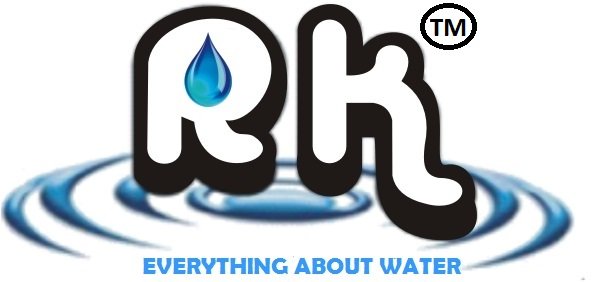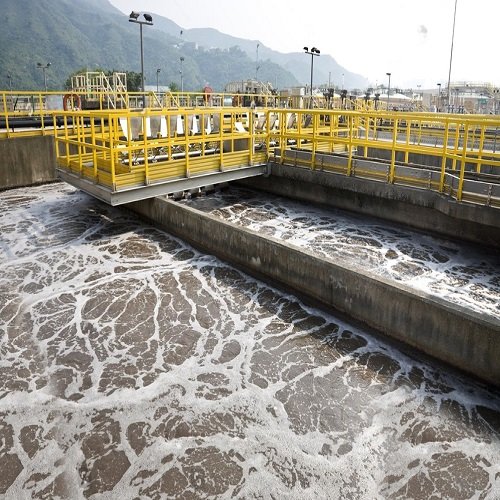ACTIVATED SLUDGE PROCESS
The activated sludge process is a biological wastewater treatment process in which a mixture of wastewater and biological sludge containing a spectrum of microorganisms is agitated and aerated. The biological solids are subsequently separated from the treated wastewater and returned to the aeration process to maintain the required mass of microorganisms for a given application.
The activated sludge process derives its name from the particular biomass formed when the air is continuously injected into the wastewater. In this process, microorganisms are mixed thoroughly with the organics, under conditions that stimulate their growth through the use of the organics as food. As the microorganisms grow and are mixed by the agitation as food. As the microorganisms clump together (flocculate) to form a suspended culture of biomass termed ‘activated sludge’. In practice, the wastewater flows continuously into an aeration tank where air or oxygen is injected to mix the activated sludge with the wastewater and to supply the oxygen needed for the suspended biomass to break down the organics. In conventional activated sludge systems, the wastewater is aerated for 6-8 hours. The mixture of activated sludge in the aeration tank, termed ‘mixed liquor’, then flows from the aeration tank to a secondary clarifier, where the activated sludge is settled out. A portion of the settled sludge is returned to the aeration tank to maintain the high population of microorganisms necessary for the rapid breakdown of the organics. Because more activated sludge is produced than can be used in the process, some of the return sludge is diverted to the sludge handling system for treatment and ultimate disposal.
Diffused aeration through aeration membrane tubes/ pads/ discs has completely replaced the Surface aerators due to reduced space requirements and improved efficiency factors.
Fine bubble diffuser membranes (fixed type/ removable type/ removable grid type employed) help in providing an even distribution of air to the microbes across the basin. Air is supplied by Aeration blowers and more often the aeration volume is automatically adjusted with the Dissolved Oxygen in the aerated effluent to save power.
The biologically treated effluent is transferred to Secondary Clarifiers.
The sludge from the clarifier is continuously re-circulated to the Activated Sludge process to maintain the MLSS and a part of the bio-sludge is periodically wasted. The wasted bio sludge is de-watered with the de-watered sludge is sent to land fill sites.
SEQUENTIAL BATCH REACTORS (SBR)
Sequencing Batch Reactor System is a fill and draws Activated Sludge System. SBR process uses high-efficiency oxygen transfer aeration equipment to satisfy the high-rate oxygen consumption requirement at the beginning of the “fill” and “aeration” cycles. SBR is efficient in carbonaceous pollutant removal and is easily modified to satisfy nutrient removal of nitrogen (N) and phosphorous (P). Because the fill, aeration, settlement, and draw take place in the same reaction tank, thus SBR tank itself also serves as the clarifier itself.
The major differences between SBR and conventional continuous-flow activated sludge system are that the SBR tank carries out the functions of equalization aeration and sedimentation in a time sequence rather than in the conventional space sequence of continuous-flow systems. In addition, the SBR system can be designed with the ability to treat a wide range of influent volumes whereas the continuous system is based upon a fixed influent flow rate. Thus, there is a degree of flexibility associated with working at a time rather than in a space sequence.
SBRs produce sludge with good settling properties providing the influent wastewater is admitted into the aeration in a controlled manner.
RK Water provides Sequencing Batch Reactor wastewater treatment plant and process design services, consulting, retrofitting and integration with wastewater treatment units.
Benefit:
- Batch Cycle Adopted With Decantation Avoiding Secondary Clarifier
- Greatly Buffers Shock Loads (Tolerates wide swings in flow and organic loading)
- Flow Equalization
- No Foaming And Bulking
- Co-Current Nitrification, De-Nitrification & Phosphorous Removal (Nutrient removal without chemicals – nitrification and de-nitrification, phosphate removal)
- Automatic Control On Dissolved Oxygen Possible
- Lower costs than conventional Activated Sludge Process
MEMBRANE BIO REACTORS (MBR)
Membrane Bio Reactor (MBR) technology is characterized by a combination of biological wastewater treatment (WWT) and membrane separation, by which biomass can be retained in the system without conventional gravity sedimentation. This leads to well-characterized advantages of the technology over conventional activated sludge processes, including smaller reactor footprint, excellent effluent quality, and smaller sludge production.
RK Water designs, integrates and installs MBR system using both flat sheet type membranes and hollow fibre membranes based on system requirement and client’s preferences.
Benefit:
- Continuous Process
- Various technologies available – Flat Membrane, Hollow Fibres, Forced Cleaning
- Modular skids available, hence expansion is easier
- Clear permeate water produced thereby reducing filtration step
- The system operates at a higher MLSS of 8000 – 15000 mg/l and thereby reduces the footprint of aeration tanks in comparison to Conventional Activated Sludge Process. It further obliterates the need of secondary clarifier thereby further reducing the overall footprint of the Biological Treatment system
- Can be fed directly for RO treatment. Avoids requirement of pressure filtration units/ Ultra-filtration.
MOVING BED BIO REACTOR (MBBR)
The MBBR process can be used for a Varity of different applications to attain the desired results, depending on the quality of wastewater and the discharge regulations.
Major Benefits:
- Lower footprint
- Cost Efficient
- Minimize process complexity
- Easy to shipment
- Less time is required at site for installation / erection.
- Less Civil work
As the sewage generation pattern was not regular, to equalize the flow an equalization tank / sump was designed considering peak water flow. The raw sewage shall be collected in a Equalization / Collection Sump. The sewage contains floating solids and to remove floating solids, we provide Screen chamber and also to remove oil from sewage we provide Oil & Grease Trap at the inlet of equalization / collection tank.
Two MBBR reactors were provided in series for better efficiency. The sewage, received at equalization / collection tank shall be pumped to the MBBR reactor. The sewage treatment plant is designed as attached growth aerobic process using floating polypropylene media. The Aeration tank shall operate as Moving Bed Bio Reactor (MBBR). In the MBBR tank, sufficient aeration time shall be provided to obtain good growth of the biomass. The floating media provides sufficient surface for biological growth. The oxygen required for the bio growth shall be provided by the aeration blower provided near the plant. Bubble diffusers in aeration tank shall provide optimum oxygen transfer required for biodegradation of sewage.
The treated sewage from the MBBR tank shall be taken to the tube settler / plate separator. In the tube settler, the biomass shall separate and clarified sewage shall be taken to clarified sewage tank. It reduced requirement of space as tube / plate provided large surface area for faster settling of sludge and eliminate the need for moving parts like in conventional clarifiers. The settled sludge will be taken to sludge drying bed / filter press / centrifuge. The dewatered sludge can be used for gardening as manure.
The clarified water from the plant shall be pumped to the Pressure Sand Filter and Activated Carbon Filter or Dual Media Filter to remove fine suspended solids, odour and colour. The treated sewage shall be chlorinated by Hypochlorite dosing in Treated Sewage Sump, and shall be reused for gardening and toilet flushing.



